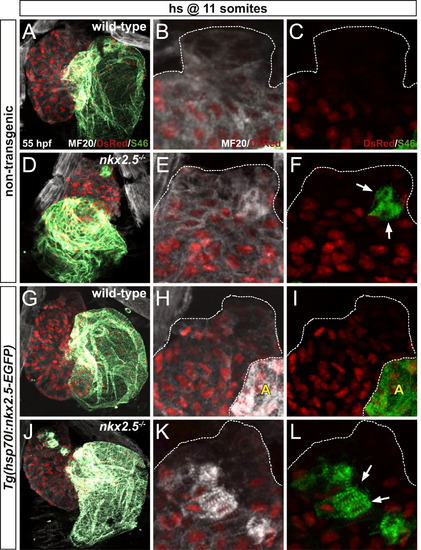Fig. 4
- ID
- ZDB-FIG-150422-53
- Publication
- George et al., 2015 - An early requirement for nkx2.5 Ensures first and Second heart field ventricular identity and cardiac function into adulthood
- Other Figures
- All Figure Page
- Back to All Figure Page
|
nkx2.5 is necessary to maintain ventricular identity in late-differentiating cardiomyocytes derived from the SHF. MF20/S46 immunofluorescence distinguishes ventricular myocardium (white) from atrial myocardium (green) in non-transgenic (A-F) and Tg(hsp70l:nkx2.5-EGFP) (G-L) embryos. Confocal projections of wild-type (A-C, G-I) and nkx2.5-/- (D?F, J?L) hearts depict cardiomyocyte nuclei with Tg(-5.1myl7:nDsRed2) (red). Ventral views, arterial pole to the top, at 55 hpf. (B,C,E,F,H,I,K,L) White dots outline the MF20+ cardiomyocyte borders in the OFTs of hearts in (A,D,G,J), respectively. White arrows indicate ectopic S46+ cells; ?A? denotes atrium. All embryos were heat-shocked at 11 somites. (A?C) In wild-type non-transgenic hearts, the late-differentiating cardiomyocyte population exhibits MF20, but not DsRed, fluorescence due to the delay in expression of Tg(-5.1myl7:nDsRed2) at the arterial pole. (D?F) Similarly, in non-transgenic nkx2.5-/- hearts, cardiomyocytes expressing MF20, but not DsRed, are present at the arterial pole. A few ectopic S46+ cardiomyocytes are also visualized in this region (DsRed nuclei). (G?I) In transgenic wild-type hearts, MF20, but not DsRed, fluorescence at the arterial pole designates the delayed differentiation of these SHF-derived cardiomyocytes. (J?L) Despite the rescue of the cardiac chamber morphology and identity, excess S46+ cardiomyocytes are visualized at the arterial pole of transgenic nkx2.5-/- hearts where the late-differentiating population accretes (DsRed nuclei). |
| Gene: | |
|---|---|
| Antibodies: | |
| Fish: | |
| Condition: | |
| Anatomical Terms: | |
| Stage: | Long-pec |
Reprinted from Developmental Biology, 400(1), George, V., Colombo, S., Targoff, K.L., An early requirement for nkx2.5 Ensures first and Second heart field ventricular identity and cardiac function into adulthood, 10-22, Copyright (2015) with permission from Elsevier. Full text @ Dev. Biol.

